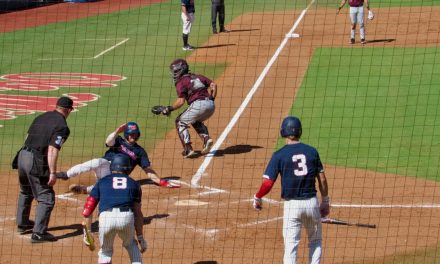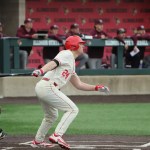
BARNEStorming: Thoughts Around the College Football World

Note: Our Steve Barnes continues his weekly column “BARNEStorming: Thoughts Around the College Football World,” where he offers his musings on the game we all love.
OXFORD, Miss. – Ole Miss has an almost embarrassment of riches of offensive playmakers. Multiple quarterbacks, running backs, wide receivers and tight ends give the Rebels an arsenal most teams can only envy.
But what if there were a way for Ole Miss to get even more of those playmakers together on the field more often?
It might be possible. What if the Rebels ran the Wishbone?
Just hear me out.
It may sound radical, but it does make sense. The Wishbone is an offense from the 70’s that implements a three-back backfield.
Texas implemented it in 1968 after Longhorns’ head coach Darrell Royal watched Texas A&M beat Alabama in the Cotton Bowl using an option offense. Royal went back to Austin and instructed his then-offensive coordinator, and future Texas A&M and Mississippi State head coach, Emory Bellard, to help come up with a new, innovative offense.
Thus, Bellard’s Wishbone was born.
After tying its first game with the new offense, Texas won its next 30 games and a couple of national championships. In 1971, Royal showed the offense to Bear Bryant, and Alabama began to use it—as did Oklahoma. Needless to say, it was successful for each of them.
“The Wishbone in its purest form consists of one split end with a tight end, a quarterback under center, a fullback approximately three yards behind the quarterback, and two halfbacks on each side of the fullback aligned about four yards behind the offensive guards, forming the Wishbone-shaped backfield,” says former four-year A&M starter at quarterback — and Rebel Walk writer — David Walker.
David executed to perfection the Aggies’ triple option out of the Wishbone in its early years of development–and won a lot of games in the scheme, finishing his eligibility as the winningest QB in A&M history.
“The most primary play out of the Wishbone is the fullback dive where the quarterback places the ball into the fullback’s stomach and carries out the fake to the outside with his two halfbacks,” David explains. “The fullback dive is aimed at the outside leg of the offensive guard.
“So, from the fullback dive, the next play is the option where the quarterback fakes to the fullback and goes down the line of scrimmage and options the defensive end by either pitching the ball to a trailing halfback or cutting upfield himself,” Walker explains.
While the Wishbone formation, itself, is now extinct in college football, its principles (blocking schemes and backfield execution) remain alive at the service academies. Army, Navy, and Air Force use a Flex-Bone which puts both halfbacks into the slot, leaving the fullback in the backfield behind the quarterback. It has two split ends, instead of the Wishbone’s standard one.
With the talent the Rebels have, just imagine the players Ole Miss could rotate every few plays to stay fresh.
For example, the Wishbone quarterback has been described as a running back who can throw. Well, the Rebels have a few of those.
In our Ole Miss version of the Wishbone, John Rhys Plumlee, Matt Corral, and Grant Tisdale would have the QB duties.
They could use 270-pound powerhouse Octavius Cooley at fullback with Jason Pellerin at tight end.
They would be joined by Jerrion Ealy and Scottie Philips as halfbacks—or any combination that also could include Snoop Conner, Isaiah Woullard and D’Vaughn Pennamon.
Elijah Moore and Jonathan Mingo could alternate at split ends—as could Dontario Drummond, Demarcus Gregory, Braylon Sanders, Jadon Jackson, Miles Battle, Tylan Knight, and Dannis Jackson. Which poison would defenses want to try?
With so many talented players, depth wouldn’t be a problem as all those Rebels could get meaningful playing time. Defenses would be out of gas after a series or two.
Sigh….it won’t happen, but a guy can “Wish.”
OLE MISS PULLING FOR BAMA?
In a word, yes.
Alabama heads to College Station this Saturday, a week before the Aggies come to Oxford.
In 2012, Texas A&M beat the Tide in Tuscaloosa, 29-24. Johnny Manziel notched 253 yards passing and two touchdowns to go with his 92 yards rushing. Alabama simply could not chase Manziel around for four quarters and the Tide suffered its only loss of the season.
But why was Bama running on empty?
The week prior Alabama outlasted LSU in Baton Rouge 21-17. The Tide finally won the game when A.J. McCarron tossed a swing pass to T.J. Yeldon who took it 28 yards for the winning score with 51 seconds left.
The game drained Alabama emotionally and it was a knock-down-drag-out physically.
If that same type of game occurs Saturday, then Texas A&M may limp into Oxford physically and be spent emotionally. Not the ideal condition to be in against the Ole Miss weapons.
TWO MORE GO DOWN
South Carolina, Kentucky and Florida have already lost quarterbacks to season-ending injuries. Last week, the Gators’ Kyle Trask and Missouri’s Kelly Bryant each went down to knee injuries. Trask returned later and Bryant was held out for the rest of the game. Each is expected to return to the field this week.
Still, that depth at quarterback on the Ole Miss roster is looking pretty good right now.
IMPRESSIVE
The most impressive thing in college football this year has not been an amazing run or an acrobatic catch. It was a drive.
Wednesday, Appalachian State was clinging to a field goal lead at Louisiana when the Mountaineers took possession at their own three-yard line early in the fourth quarter. Most teams would want to gain a first down or two and then punt and try to hold the opponent from scoring.
App State had other ideas.
The Mountaineers mounted a 19-play, 97-yard drive that melted more than ten minutes off the clock. App State scored a touchdown to end the march.
Instead of giving the Ragin’ Cajuns the ball with a chance to win, the Mountaineers gave Louisiana the ball leading by 10.
They did not ice the game, they put it in a cryogenic state.
GROUP OF FIVE PLAYOFFS
It is still a fantasy, but if the Group of Five schools got together for a playoff, it would be a pretty good tournament. UCF has dropped out of the running for the spot, as has Army this week.
As of now, the four teams would be Boise State, Memphis, Cincinnati and for the first time since the 80s when its payroll was higher than the Dallas Cowboys, SMU.
Steve Barnes joins The Rebel Walk staff as a senior writer and brings a trifecta of journalistic experience. As a writer, he has covered college sports for Rivals.com, Football.com and SaturdayDownSouth.com as well as served as a beat writer for various traditional newspapers.
He has been a broadcaster for arena football and several national tournament events for the National Junior College Athletic Association as well as hosting various shows on radio.
A former sports information director at Albany (Ga.) State University and an assistant at Troy and West Florida, he has helped host many NCAA conference, regional and national events, including serving five years on the media committee of the NCAA Division II World Series.
Barnes, a native of Pensacola, Fla., attended Ole Miss in 1983-84, where his first journalism teacher was David Kellum. The duo has come a long way since that time.
He will bring a proven journalistic track record, along with a knack for finding the out-of-the-ordinary story angles to The Rebel Walk.
Barnes continues to reside in Pensacola a mere ten minutes from the beach because he does have taste and a brain.























